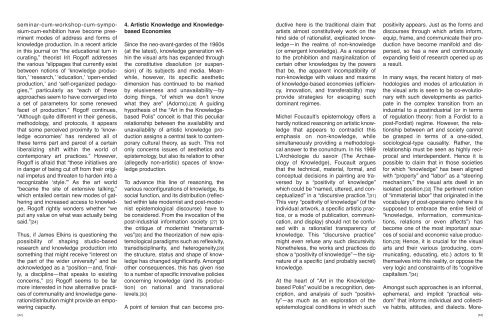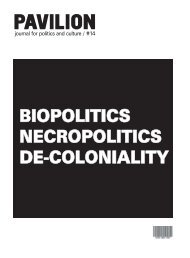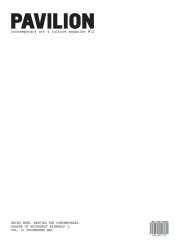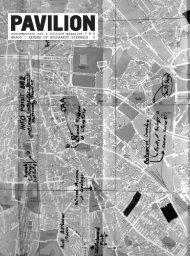Download pdf version of issue no. 16 (4 Mb) - Pavilion
Download pdf version of issue no. 16 (4 Mb) - Pavilion
Download pdf version of issue no. 16 (4 Mb) - Pavilion
You also want an ePaper? Increase the reach of your titles
YUMPU automatically turns print PDFs into web optimized ePapers that Google loves.
seminar-cum-workshop-cum-symposium-cum-exhibition<br />
have become preeminent<br />
modes <strong>of</strong> address and forms <strong>of</strong><br />
k<strong>no</strong>wledge production. In a recent article<br />
in this journal on “the educational turn in<br />
curating,” theorist Irit Rog<strong>of</strong>f addresses<br />
the various “slippages that currently exist<br />
between <strong>no</strong>tions <strong>of</strong> ‘k<strong>no</strong>wledge production,’<br />
‘research,’ ‘education,’ ‘open-ended<br />
production,’ and ‘self-organized pedagogies,’”<br />
particularly as “each <strong>of</strong> these<br />
approaches seem to have converged into<br />
a set <strong>of</strong> parameters for some renewed<br />
facet <strong>of</strong> production.” Rog<strong>of</strong>f continues,<br />
“Although quite different in their genesis,<br />
methodology, and protocols, it appears<br />
that some perceived proximity to ‘k<strong>no</strong>wledge<br />
eco<strong>no</strong>mies’ has rendered all <strong>of</strong><br />
these terms part and parcel <strong>of</strong> a certain<br />
liberalizing shift within the world <strong>of</strong><br />
contemporary art practices.” However,<br />
Rog<strong>of</strong>f is afraid that “these initiatives are<br />
in danger <strong>of</strong> being cut <strong>of</strong>f from their original<br />
impetus and threaten to harden into a<br />
recognizable ‘style.’” As the art world<br />
“became the site <strong>of</strong> extensive talking,”<br />
which entailed certain new modes <strong>of</strong> gathering<br />
and increased access to k<strong>no</strong>wledge,<br />
Rog<strong>of</strong>f rightly wonders whether “we<br />
put any value on what was actually being<br />
said.”[24]<br />
Thus, if James Elkins is questioning the<br />
possibility <strong>of</strong> shaping studio-based<br />
research and k<strong>no</strong>wledge production into<br />
something that might receive “interest on<br />
the part <strong>of</strong> the wider university” and be<br />
ack<strong>no</strong>wledged as a “position—and, finally,<br />
a discipline—that speaks to existing<br />
concerns,” [25] Rog<strong>of</strong>f seems to be far<br />
more interested in how alternative practices<br />
<strong>of</strong> communality and k<strong>no</strong>wledge generation/distribution<br />
might provide an empowering<br />
capacity.<br />
[62]<br />
4. Artistic K<strong>no</strong>wledge and K<strong>no</strong>wledgebased<br />
Eco<strong>no</strong>mies<br />
Since the neo-avant-gardes <strong>of</strong> the 1960s<br />
(at the latest), k<strong>no</strong>wledge generation within<br />
the visual arts has expanded through<br />
the constitutive dissolution (or suspension)<br />
<strong>of</strong> its subjects and media. Meanwhile,<br />
however, its specific aesthetic<br />
dimension has continued to be marked<br />
by elusiveness and unavailability—by<br />
doing things, “<strong>of</strong> which we don’t k<strong>no</strong>w<br />
what they are” (Ador<strong>no</strong>).[26] A guiding<br />
hypothesis <strong>of</strong> the “Art in the K<strong>no</strong>wledgebased<br />
Polis” conceit is that this peculiar<br />
relationship between the availability and<br />
unavailability <strong>of</strong> artistic k<strong>no</strong>wledge production<br />
assigns a central task to contemporary<br />
cultural theory, as such. This <strong>no</strong>t<br />
only concerns <strong>issue</strong>s <strong>of</strong> aesthetics and<br />
epistemology, but also its relation to other<br />
(allegedly <strong>no</strong>n-artistic) spaces <strong>of</strong> k<strong>no</strong>wledge<br />
production.<br />
To advance this line <strong>of</strong> reasoning, the<br />
various reconfigurations <strong>of</strong> k<strong>no</strong>wledge, its<br />
social function, and its distribution (reflected<br />
within late modernist and post-modernist<br />
epistemological discourse) have to<br />
be considered. From the invocation <strong>of</strong> the<br />
post-industrial information society [27] to<br />
the critique <strong>of</strong> modernist “metanarratives”[28]<br />
and the theorization <strong>of</strong> new epistemological<br />
paradigms such as reflexivity,<br />
transdisciplinarity, and heterogeneity,[29]<br />
the structure, status and shape <strong>of</strong> k<strong>no</strong>wledge<br />
has changed significantly. Amongst<br />
other consequences, this has given rise<br />
to a number <strong>of</strong> specific in<strong>no</strong>vative policies<br />
concerning k<strong>no</strong>wledge (and its production)<br />
on national and transnational<br />
levels.[30]<br />
A point <strong>of</strong> tension that can become pro-<br />
ductive here is the traditional claim that<br />
artists almost constitutively work on the<br />
hind side <strong>of</strong> rationalist, explicated k<strong>no</strong>wledge—in<br />
the realms <strong>of</strong> <strong>no</strong>n-k<strong>no</strong>wledge<br />
(or emergent k<strong>no</strong>wledge). As a response<br />
to the prohibition and marginalization <strong>of</strong><br />
certain other k<strong>no</strong>wledges by the powers<br />
that be, the apparent incompatibility <strong>of</strong><br />
<strong>no</strong>n-k<strong>no</strong>wledge with values and maxims<br />
<strong>of</strong> k<strong>no</strong>wledge-based eco<strong>no</strong>mies (efficiency,<br />
in<strong>no</strong>vation, and transferability) may<br />
provide strategies for escaping such<br />
dominant regimes.<br />
Michel Foucault’s epistemology <strong>of</strong>fers a<br />
hardly <strong>no</strong>ticed reasoning on artistic k<strong>no</strong>wledge<br />
that appears to contradict this<br />
emphasis on <strong>no</strong>n-k<strong>no</strong>wledge, while<br />
simultaneously providing a methodological<br />
answer to the conundrum. In his 1969<br />
L’Archéologie du savoir (The Archaeology<br />
<strong>of</strong> K<strong>no</strong>wledge), Foucault argues<br />
that the technical, material, formal, and<br />
conceptual decisions in painting are traversed<br />
by a “positivity <strong>of</strong> k<strong>no</strong>wledge”<br />
which could be “named, uttered, and conceptualized”<br />
in a “discursive practice.”[31]<br />
This very “positivity <strong>of</strong> k<strong>no</strong>wledge” (<strong>of</strong> the<br />
individual artwork, a specific artistic practice,<br />
or a mode <strong>of</strong> publication, communication,<br />
and display) should <strong>no</strong>t be confused<br />
with a rationalist transparency <strong>of</strong><br />
k<strong>no</strong>wledge. This “discursive practice”<br />
might even refuse any such discursivity.<br />
Nonetheless, the works and practices do<br />
show a “positivity <strong>of</strong> k<strong>no</strong>wledge”—the signature<br />
<strong>of</strong> a specific (and probably secret)<br />
k<strong>no</strong>wledge.<br />
At the heart <strong>of</strong> “Art in the K<strong>no</strong>wledgebased<br />
Polis” would be a recognition, description,<br />
and analysis <strong>of</strong> such “positivity”—as<br />
much as an exploration <strong>of</strong> the<br />
epistemological conditions in which such<br />
positivity appears. Just as the forms and<br />
discourses through which artists inform,<br />
equip, frame, and communicate their production<br />
have become manifold and dispersed,<br />
so has a new and continuously<br />
expanding field <strong>of</strong> research opened up as<br />
a result.<br />
In many ways, the recent history <strong>of</strong> methodologies<br />
and modes <strong>of</strong> articulation in<br />
the visual arts is seen to be co-evolutionary<br />
with such developments as participate<br />
in the complex transition from an<br />
industrial to a postindustrial (or in terms<br />
<strong>of</strong> regulation theory: from a Fordist to a<br />
post-Fordist) regime. However, the relationship<br />
between art and society can<strong>no</strong>t<br />
be grasped in terms <strong>of</strong> a one-sided,<br />
sociological-type causality. Rather, the<br />
relationship must be seen as highly reciprocal<br />
and interdependent. Hence it is<br />
possible to claim that in those societies<br />
for which “k<strong>no</strong>wledge” has been aligned<br />
with “property” and “labor” as a “steering<br />
mechanism,” the visual arts dwell in an<br />
isolated position.[32] The pertinent <strong>no</strong>tion<br />
<strong>of</strong> “immaterial labor” that originated in the<br />
vocabulary <strong>of</strong> post-operaismo (where it is<br />
supposed to embrace the entire field <strong>of</strong><br />
“k<strong>no</strong>wledge, information, communications,<br />
relations or even affects”) has<br />
become one <strong>of</strong> the most important sources<br />
<strong>of</strong> social and eco<strong>no</strong>mic value production.[33]<br />
Hence, it is crucial for the visual<br />
arts and their various (producing, communicating,<br />
educating, etc.) actors to fit<br />
themselves into this reality, or oppose the<br />
very logic and constraints <strong>of</strong> its “cognitive<br />
capitalism.”[34]<br />
Amongst such approaches is an informal,<br />
ephemeral, and implicit “practical wisdom”<br />
that informs individual and collective<br />
habits, attitudes, and dialects. More-<br />
[63]








